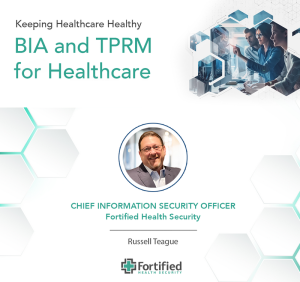The rising costs associated with cybersecurity breaches, like the Change Healthcare incident and CrowdStrike breach, underscore the severe consequences and need for third-party risk management in healthcare.
These incidents serve as urgent reminders of how much damage can result from unmitigated vulnerabilities. Healthcare organizations, which rely heavily on third-party vendors and external partners, must actively take steps to safeguard their operations. But the question remains: How can your organization prepare for and effectively manage third-party risks in healthcare?
During a recent webinar, Keeping Healthcare Healthy: BIA and TPRM for Healthcare, Russell Teague, the Chief Information Security Officer (CISO) of Fortified Health Security, addressed this very issue. He shared valuable insights on how healthcare organizations, much like yours, can develop a comprehensive Business Impact Analysis (BIA) alongside a Third-Party Risk Management in healthcare (TPRM) strategy. These tools, he emphasized, are essential for preparing for the inevitable breach and minimizing its impact.
Third-Party Risk Management in Healthcare: Where to Begin

Teague pointed out during the webinar that many healthcare systems remain unaware of the real cybersecurity risks within their operations. One of the most significant — over-reliance on a single point of failure.
“A new term that I think we’re starting to talk about in healthcare is around single points of failure,” Teague explained. “We h
ave a single point of failure in a technology where you’re only one technology deep. If that technology fails, you either have no coverage, no protection.”
This vulnerability is especially dangerous in healthcare, where the failure of a single system can leave entire organizations exposed. For instance, a breach in a third-party vendor’s technology can cascade across multiple systems, disrupting patient care and potentially exposing sensitive health information.
To mitigate and manage third-party risks in healthcare and address these single points of failure, Teague emphasized the importance of diversification. Healthcare organizations should avoid putting all their trust in a single vendor or technology. Instead, they should distribute their reliance across multiple layers of protection to minimize risk.
Teague also advised that it’s not enough to simply trust vendors or ask them to comply with your policies. “You can no longer just ask, ‘Hey, are you willing to comply with our policies?’” said Teague. “You actually need to check, verify, and hold them accountable for their environment.”
This requires taking a proactive approach to assessing vendor security, ensuring that their systems and practices meet rigorous standards, and holding them accountable when they don’t.
Finding the Right Partner for Third-Party Risk Management in Healthcare
In today’s cyber environment, resilience isn’t a luxury—it’s an absolute necessity. Healthcare leaders need to shift from a reactive stance to a proactive one to withstand the growing number of cyberattacks and protect both their organizations and their patients. Building robust cyber resilience requires more than just implementing policies; it demands ongoing vigilance and adaptability. That includes implementing strategies for third-party risk management in healthcare.
This is where Fortified Health Security steps in.
Partnering with healthcare organizations to protect them from the rising tide of cybercrime is our core mission. We provide specialized services designed to help healthcare providers manage their cybersecurity programs effectively, and one of our key offerings is third-party risk management for healthcare.
Through our Central Command service delivery platform, Fortified simplifies the complexities associated with managing a cybersecurity program. This platform helps organizations monitor and address third-party risks, ensuring that they remain secure, compliant, and resilient in the face of evolving threats.
For healthcare organizations seeking to better understand their cybersecurity risks and next steps, watch our Keeping Healthcare Healthy: BIA and TPRM for Healthcare webinar.
You can also reach out directly to learn more about how our services can protect against the next major breach. Contact us today.